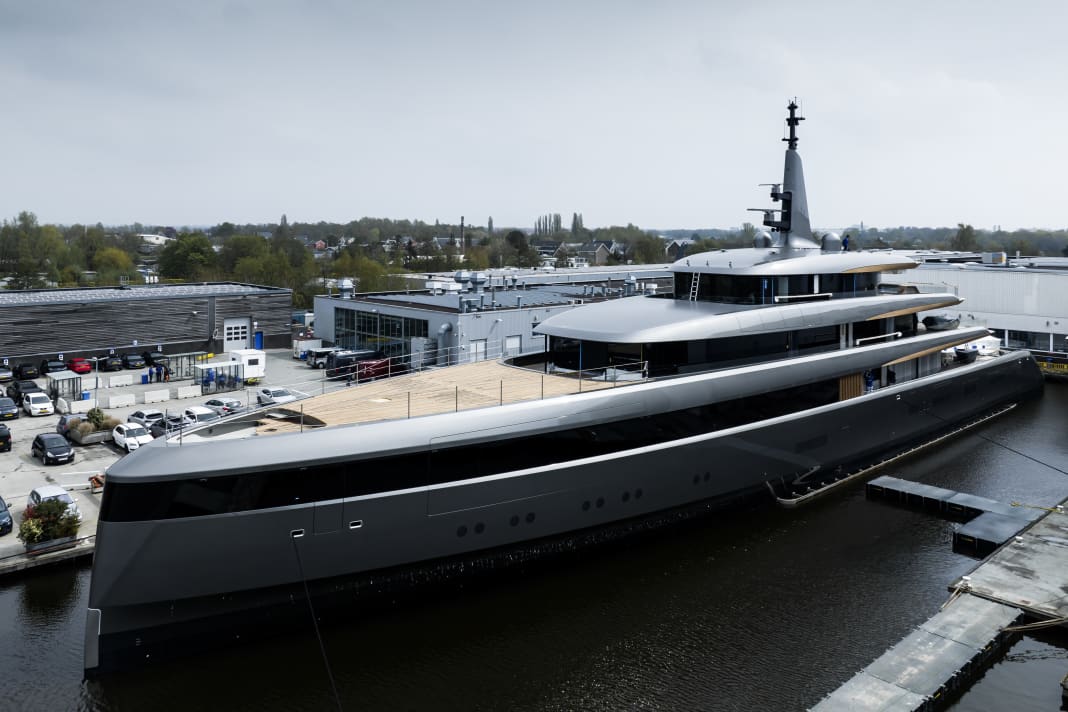





The no-frills exterior design of the British RWD studio reveals not one bevel too many. The most extravagant features are the wing shapes in the superstructure, while the feathered appearance is emphasised by the wooden surfaces. Otherwise, the clean lines prevail: glass bulwark, integrated life rafts, hull hatches and a mast made from a single piece. The main deck window strip runs around the bow and emphasises the horizontality. However, the hull hatch of the tender garage and the mooring platform folded down in the pictures speak against an extended master suite in the foredeck and in favour of a panorama lounge. This should be accessible either via a corridor or the lower deck. In fact, it looks as if the owners occupy the main deck and the bridge is located on the top deck. Below the stern, large windows are set into the underwater hull. An unusual feature is the location of a dining saloon on the lower deck, which opens out to the sea via a hull hatch wall. When planning the layout, MONK Design and RWD benefited from the single-storey engine room, which Feadship realised for the first time on a yacht of this size.
The use of the biofuel HVO, which Feadship intends to bunker as pure fuel for seatrials and delivery, is also a novelty. The acronym stands for "Hydrotreated Vegetable Oil". The diesel substitute is also produced on the basis of used cooking oil and by means of a catalytic reaction with the addition of hydrogen. This is said to reduce emissions by 90 per cent and is being tested by Deutsche Bahn on the railways. Unlike in the Netherlands, HVO may not be offered as a pure fuel at German petrol stations.
Diesel substitute as pure fuel
On Project 710, the biofuel flows into four variable-speed generators from Caterpillar. The electricity generated ends up in two counter-rotating pod drives from Veth, in which electric motors are integrated and which also act as rudders. Part of the diesel-electric hybrid drive is a battery bank with a capacity of 4500 kilowatt hours - that is 4.5 times higher than on Feadship's first hybrid yacht "Savannah". The declared goal: maximise efficiency, minimise vibrations.
The waste heat from the customised variable-speed generators and the air conditioning system will also be used to heat the air conditioning system, pool water, service water, preheat the engines and much more. A heat pump system will be used to extract heat from the seawater. Feadship wants to present an emission-free yacht (in operation) by 2030. The Dutch are relying on hydrogen as a future energy source, but unlike Lürssen, they want to use it directly and store it in pressurised tanks that have been cooled down considerably.
Technical data Feadship Project 710
- Overall length: 84.20 m
- Width: 13.60 m
- Draught: 3.75 m
- Fuel: 240 m³
- Water: 50 m³
- Construction: Feadship De Voogt Naval Architects
- Exterior design: RWD with MONK Design
- Interior design: RWD with MONK Design
- Pods: 2 x VETH L-drive 1550i
- Generators: 4 x Custom Caterpillar C32
- Speed: (max/cruise): 17 / 12 kn
- Range @12 kn: 5500 nm
